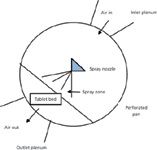Pan Coating and Scale-Up: a Practical Guide Based on First Principles
Pharmaceutical Technology Europe
There are various theories about how to scale up a solid dosage coating operation in a pan coater. This article provides a basic process understanding and scale-up theory based on first principles.
The coating process indicated in Figure 1 is an operation that comprises multiple, simultaneous ongoing exchange processes. These processes include:
- Heat exchange between inlet process air and the coater metal body, spray droplets and tablets.
- Mass exchange between material sprayed, and the inlet air stream, tablets and coating pan.

Figure 1: Pan-coating process.
However, there are certain losses, such as heat loss to the metal body and the environment, that cannot be characterised easily. An approximate mass and energy balance for the operation can be calculated as below.
Equilibrium state at coating process
Heat balance:

As with any theoretical analysis, there are assumptions built into the model described above. For example:
- Leftover material in lines are not considered.
- Heat loss to equipment body and environment are not considered.
- Any unrecoverable mass loss in the process is not accounted for.
These steps can be used to measure process efficiency and efficiency of the inlet air heat capacity. These actions are beneficial because the process scientist may realise that only a small fraction of heat–mass uptake capacity is being utilised. It may or may not be possible to change this. As long as the total process reconciliation is acceptable (e.g., within 2%), the process efficiency can be calculated as a ratio of tablet weight gain to the weight of solids sprayed. As the process is scaled up, the increased bed depth will generally improve coating efficiency, thus providing better opportunity for process air to exchange heat with the tablets.
Similarly, spray gun positioning, relative to the bed and to the inlet air plenum, will affect the drying process of spray droplets. In general, the greatest impact depends upon the distance of the spray gun from the bed, atomisation/fan air pressures and nozzle type/diameter.
Scaling up the coating process
Various articles on scale-up principles have been published (1–3). The following are basic scale-up principles that can be applied easily in practice:
- Batch size scale-up is largely dependent on the pan size. As a general rule, the bed depth in proportion to the pan depth should be kept constant. This proportion will help to achieve consistent tablet flow in the scale-up batch, assuming the pans have similar dimensions. However, the technique can also be useful even if the pans are not geometrically similar.
- Pan RPM scale-up is based on the industry's accepted principle of using the linear distance travelled by tablets in the pan per unit time as constant, and can be applied to obtain similar dynamic conditions during scale-up. The linear distance is calculated as πD, where D is the pan diameter. Using this principle, the following calculation will provide the pan RPM:

- Air flow scale-up. Air flow is frequently limited by the particular equipment and/or blowers installed on the system. It is important—particularly for functional coatings—to keep the drying kinetics constant as the process is scaled up. This action can be accomplished in accordance with the spray rate scale-up presented below.
- Spray rate scale-up needs to be in step with air flow scale-up. The coordination should be based on more than the batch size increase because equipment that provides a five-fold batch size increase may only allow a two-fold increase in process air. As a general rule, product temperature should be constant across scales. It's often possible to increase the temperature to allow for higher spray rate during scale-up, but this increase depends on the sensitivity of the coating material, or polymer, and its film-forming properties.
The general principles described above underpin the tablet coating process and can support successful scale-up.
Abhishek Kathuria is technical manager at Evonik Pharma Polymers.
References
1. R. Turton and X.X. Cheng, Powder Technology, 150, 78–85 (2005).
2. S.C. Porter, "Scale-up of film coating", Pharmaceutical Process Scale-Up, M. Levin, Ed., (Marcel Dekker Inc, New York, USA, 2000), pp. 259–310.
3. G.B. Tatterson, Scaleup and Design of Industrial Mixing Processes (McGraw Hill, New York, USA, 1994.
Drug Solutions Podcast: A Closer Look at mRNA in Oncology and Vaccines
April 30th 2024In this episode fo the Drug Solutions Podcast, etherna’s vice-president of Technology and Innovation, Stefaan De Koker, discusses the merits and challenges of using mRNA as the foundation for therapeutics in oncology as well as for vaccines.
